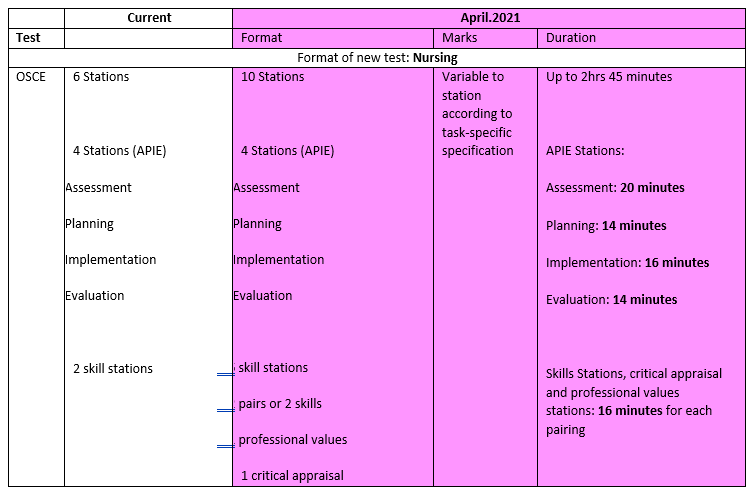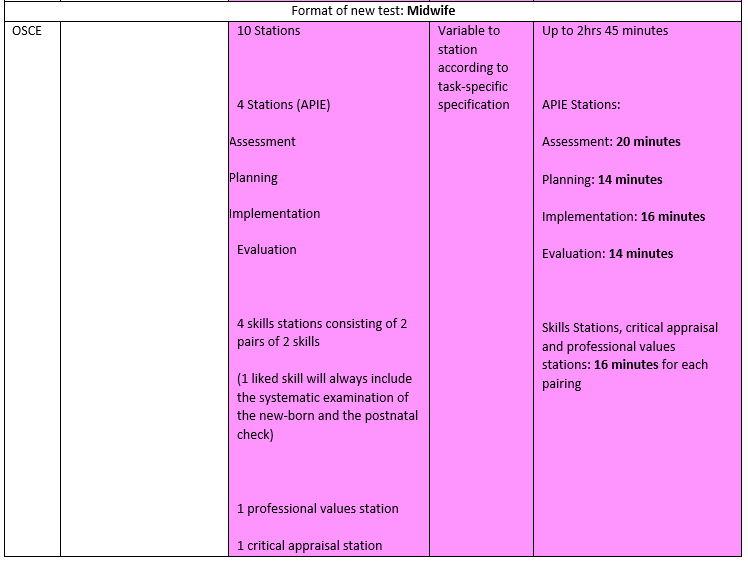What are the new OSCE stations?

- By (28 articles)
What are the new OSCE stations?
Changes in OSCE
The NMC has increased the total number of exam stations from 6 to 10. Four stations will continue to be linked together around a scenario: the APIE (assessment, planning, implementation, and evaluation, they will each have a specific station). Six skill stations will be tested instead of two.
Þ 2 pairs of 2 skills
Þ 1 professional values
Þ 1 critical appraisal
Duration:

APIE stations:
· Assessment: Full A-E assessment (airway, breathing, circulation, disability, exposure) will be included in clinical assessment.
· Planning: Stays the same- writing two care plans.
· Implementation: Stays the same – drug administration.
· Evaluation: Changes from a written referral to another healthcare professional to a non-assessed written SBAR assessment and an assessed verbal handover to another healthcare professional (the examiner).
New OSCE Patient Scenario for APIE – 2021
- Pneumonia
- Subdural
- Anxiety
- UTI
- Hernia
- Asthma
- Chronic Cardiac Failure
- Ectopic
- Dementia / Confusion
- Leg ulcer
- Diabetes
SKILL Stations
There will be a total of 14 possible skills tested in the OSCE exam.
- Administration of Inhaled Medication - Medications administered through inhalation are dispersed via an aerosol spray, mist, or powder that patients inhale into their airways. Although the primary effect of inhaled medications is respiratory, there are likely to be systemic effects as well.
- Blood Glucose Monitoring - The use of a glucose meter for testing the concentration of glucose in the blood. Particularly important in diabetes management, a blood glucose test is typically performed by piercing the skin to draw blood, then applying the blood to a chemically active disposable 'test-strip'.
- Catheter Specimen of Urine - Catheter specimens of urine (CSU) are usually collected for microscopy, culture and sensitivity (MC&S) testing when an infection has been suspected. The urine is tested to identify the organisms causing the infection as well as their sensitivities to antibiotics.
- Fine Bore NG – A fine bone nasogastric tube is a narrow bore tube passed into the stomach via the nose as a means of meeting a patient's nutritional needs when they are unable to maintain adequate oral intake.
- Fluid Balance (4 different patient variants) - Fluid balance, also known as fluid homeostasis, describes the balancing of the body’s fluid input and output levels to prevent the fluid concentration from changing. In order to maintain the necessary balance of nutrients, oxygen and water, the adult body generally requires an intake of two to three litres per day, with approximately the same output.
- Intramuscular injection - Intramuscular injection, often abbreviated IM, is the injection of a substance into a muscle. In medicine, it is one of several methods for parenteral administration of medications.
- IV flush and VIP score - All patients with an intravenous access device in place must have the IV site checked at least daily for signs of infusion phlebitis. The subsequent score AND action(s) taken (if any) must be documented.
- Pain Assessment - Pain is multidimensional therefore assessment must include the intensity, location, duration and description, the impact on activity and the factors that may influence the individual’s perception of pain.
- Peak Expiratory Flow rate - PEFR is defined as the highest flow rate out of the mouth during a rapid forced expiration (i.e. a person's maximum speed of expiration). This makes it ideal for monitoring obstructive diseases such as asthma. The greater the patency of the airway, the greater the rate of airflow.
- Pressure Area Assessment - An assessment of pressure ulcer risk should be based on clinical judgement and/or the use of a validated scale such as the Braden scale, the Water low scale or the Norton risk?assessment scale for adults and the Braden Q scale for children
- Removal of Urinary Catheter - A catheter is a flexible tube inserted into the bladder to empty it of urine. Urinary catheterisation reduces the risk of infection and kidney damage by making sure that the bladder is emptied, either continuously or at regular intervals.
- Subcutaneous injection - A subcutaneous injection is a method of administering medication. Subcutaneous means under the skin. In this type of injection, a short needle is used to inject a drug into the tissue layer between the skin and the muscle. Medication given this way is usually absorbed more slowly than if injected into a vein, sometimes over a period of 24 hours.
- Urine Analysis - Clinical urine tests are examinations of the physical and chemical properties of urine and its microscopic appearance to aid in medical diagnosis.
- Wound Assessment and Aseptic non-touch technique (ANTT) - ANTT is a method used to prevent contamination of wounds and other susceptible sites by ensuring that only sterile objects and fluids come into the contact with these sites and that the risk of contamination is minimised.
In summary,


To find out more information, please click here and you will be directed to the NMC website.
Stay up to date with the OSCE changes... Call 02036376722!

